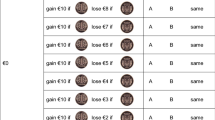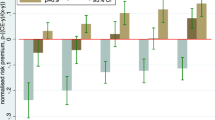Abstract
This article presents the results of an experiment that completely measures the utility function and probability weighting function for different positive and negative monetary outcomes, using a representative sample of N = 1,935 from the general public. The results confirm earlier findings in the lab, suggesting that utility is less pronounced than what is found in classical measurements where expected utility is assumed. Utility for losses is found to be convex, consistent with diminishing sensitivity, and the obtained loss-aversion coefficient of 1.6 is moderate but in agreement with contemporary evidence. The estimated probability weighting functions have an inverse-S shape and they imply pessimism in both domains. These results show that probability weighting is also an important phenomenon in the general population. Women and lower educated individuals are found to be more risk averse, in agreement with common findings. In contrast to previous studies that ascribed gender differences in risk attitudes solely to differences in the degree utility curvature, however, our results show that this finding is primarily driven by loss aversion and, for women, also by a more pessimistic psychological response toward the probability of obtaining the best possible outcome.
Article PDF
Similar content being viewed by others
Avoid common mistakes on your manuscript.
References
Abdellaoui M. (2000) Parameter-free elicitation of utilities and probability weighting functions. Management Science 46: 1497–1512
Abdellaoui M., Barrios C., Wakker P.P. (2007) Reconciling introspective utility with revealed preference: experimental arguments based on prospect theory. Journal of Econometrics 138: 356–378
Abdellaoui M., Bleichrodt H., L’Haridon O. (2008) A tractable method to measure utility and loss aversion under prospect theory. Journal of Risk and Uncertainty 36: 245–266
Abdellaoui M., Bleichrodt H., Paraschiv C. (2007) Loss aversion under prospect theory: A parameter-free measurement. Management Science 50(10): 1659–1674
Abdellaoui M., Vossmann F., Weber M. (2005) Choice-based elicitation and decomposition of decision weights for gains and losses under uncertainty. Management Science 51: 1384–1399
Allais M. (1953) Le Comportement de l’Homme Rationnel devant le Risque: critique des Postulats et Axiomes de l’Ecole Américaine. Econometrica 21: 503–546
Andersen S., Harrison G.W., Lau M.I., Rutström E. (2008) Eliciting risk and time preferences. Econometrica 76(3): 583–618
Andersen, S., Harrison, G. W., & Rutström, E. E. (2006). Dynamic choice behaviour: asset integration and natural reference points. Working paper, 06-07, Department of Economics, College of Business Administration, University of Central Florida. Available at http://www.bus.ucf.edu/wp/Working%20Papers/2006/06-07%20Harrison.pdf.
Barsky R.B., Juster F.T., Kimball M.S., Shapiro M.D. (1997) Preference parameters and behavioral heterogeneity: an experimental approach in the health and retirement study. Quarterly Journal of Economics 112: 537–579
Benartzy S., Thaler R.H. (1995) Myopic loss aversion and the equity premium puzzle. Quarterly Journal of Economics 110: 73–92
Blake D. (1996) Efficiency, risk aversion and portfolio insurance: an analysis of financial asset portfolios held by investors in the United Kingdom. Economic Journal 106: 1175–1192
Blavatskyy P. (2006) Error propagation in the elicitation of utility and probability weighting functions. Theory and Decision 60: 315–334
Blavatskyy P.R. (2007) Stochastic expected utility theory. Journal of Risk and Uncertainty 34: 259–286
Bleichrodt H., Pinto J.L. (2000) A parameter-free elicitation of the probability weighting function in medical decision analysis. Management Science 46: 1485–1496
Bleichrodt H., Pinto J.L. (2002) Loss aversion and scale compatibility in two–attribute trade–offs. Journal of Mathematical Psychology 46: 315–337
Booij, A. S., & van de Kuilen, G. (2007). A parameter–free analysis of the utility of money for the general population under prospect theory. Working paper, Amsterdam School of Economics. Available at http://booij.economists.nl/papers.php.
Byrnes J.P., Miller D.C. (1999) Gender differences in risk taking: a meta-analysis. Psychological Bulletin 125(3): 367–383
Camerer C.F. (2000) Prospect theory in the wild: evidence from the field. In: Kahneman D., Tversky A. (eds) Choices, values and frames.. Cambridge University Press, New York, pp 288–300
Camerer C.F., Ho T. (1994) Nonlinear weighting of probabilities and violations of the betweenness axiom. Journal of Risk and Uncertainty 8: 167–196
Camerer C.F., Hogarth R.M. (1999) The effects of financial incentives in experiments: a review and capital-labor-production framework. Journal of Risk and Uncertainty 19: 7–42
Carbone E., Hey J.D. (2000) Which error story is best? Journal of Risk and Uncertainty 20(2): 161–176
Cohn R.A., Lewellen W.G., Lease R.C., Schlarbaum G.G. (1975) Individual investor risk aversion and investment portfolio composition. Journal of Finance 30: 605–620
Cox J.C., Sadiraj V. (2006) Small- and large-stakes risk aversion: implications of concavity calibration for decision theory. Games and Economic Behavior 56(1): 45–60
Cubitt R.P., Starmer C., Sugden R. (2001) Discovered preferences and the experimental evidence of violations of expected utility theory. Journal of Economic Methodology 8: 385–414
Currim I.S., Sarin R.K. (1989) Prospect versus utility. Management Science 35: 22–41
Davidson D., Suppes P., Siegel S. (1957) Decision making: an experimental approach. Stanford University Press, Stanford, CA
Dohmen, T., Falk, A., Huffman, D., Sunde, U., Schupp, J., & Wagner, G. G. (2006). Individual risk attitudes: new evidence from a large, representative, experimentally-validated survey. CEPR Discussion Papers 5517.
Donkers A.C.D., Melenberg B., van Soest A.H.O. (2001) Estimating risk attitudes using lotteries: a large sample approach. Journal of Risk and Uncertainty 22: 165–195
Donkers B., van Soest A. (1999) Subjective measures of household preferences and financial decisions. Journal of Economic Psychology 20: 613–642
Etchart-Vincent N. (2004) Is probability weighting sensitive to the magnitude of consequences? An experimental investigation on losses. Journal of Risk and Uncertainty 28: 217–235
Fehr-Duda H., de Gennaro M., Schubert R. (2006) Gender, financial risk, and probability weights. Theory and Decision 60: 283–313
Fennema H., van Assen M.A.L.M. (1998) Measuring the utility of losses by means of the tradeoff method. Journal of Risk and Uncertainty 17: 277–295
Gächter, S. E., Johnson, J., & Herrmann, A. (2007). Individual-level loss aversion in riskless and risky choices. Working paper, CeDEx discussion paper 2007-02, The University of Nottingham. Available at http://www.nottingham.ac.uk/economics/cedex/papers/2007-02.pdf.
Goeree J.K., Holt C.A., Palfrey T.R. (2002) Quantal response equilibrium and overbidding in private-value auctions. Journal of Economic Theory 104: 247–272
Goette L., Huffman D., Fehr E. (2004) Loss aversion and labour supply. Journal of the European Economic Association 2: 216–228
Goldstein W.M., Einhorn H.J. (1987) Expression theory and the preference reversal phenomena. Psychological Review 94: 236–254
Gonzalez R., Wu G. (1999) On the form of the probability weighting function. Cognitive Psychology 38: 129–166
Guiso, L., & Paiella, M. (2003). Risk aversion, wealth and background risk. Bank of Italy economic working paper no. 483.
Halek M., Eisenhauer J.G. (2001) Demography of risk aversion. Journal of Risk and Insurance 68: 1–34
Harrison, G. W., Lau, M. I., Rutström, E. E., & Sullivan, M. B. (2005). Eliciting risk and time preferences using field experiments: some methodological issues. Field experiments in economics (Vol. 10). Greenwich, CT: JAI Press (Research in Experimental Economics).
Harrison, G. W., & Rutström, E. E. (2008). Risk aversion in the laboratory. In J. C. Cox & G. W. Harrison (Eds.), Risk aversion in experiments (Vol. 12, pp. 42–196). Bingley, UK: Emerald (Research in experimental economics).
Harrison, G. W., & Rutström, E. E. (2009). Expected utility theory and prospect theory: One wedding and a decent funeral. Experimental Economics 12, forthcoming. Available at http://www.bus.ucf.edu/wp/Working%20Papers/2005/05-18%20Harrison.pdf.
Hartog J., Ferrer-i-Carbonell A., Jonker N. (2002) Linking measured risk aversion to individual characteristics. Kyklos 55: 3–26
Hertwig R., Ortmann A. (2001) Experimental practices in economics: a challenge for psychologists? Behavioral and Brain Sciences 24: 383–403
Hey J.D. (1995) Experimental investigations of errors in decision making under risk. European Economic Review 39(3–4): 633–640
Hey J.D. (2005) Why we should not be silent about noise. Experimental Economics 8(4): 325–345
Hey J.D., Orme C. (1994) Investigating generalizations of expected utility theory using experimental data. Econometrica 62: 1291–1326
Holt C.A., Laury S.K. (2002) Risk aversion and incentive effects. American Economic Review 92: 1644–1655
Jullien B., Salanié B. (2000) Estimating preferences under risk: the case of racetrack bettors. Journal of Political Economy 108: 503–530
Kahneman D., Tversky A. (1979) Prospect theory: an analysis of decision under risk. Econometrica 47: 263–291
Köbberling V., Wakker P.P. (2005) An index of loss aversion. Journal of Economic Theory 122(1): 119–131
Laury S.K., Holt C.A. (2000) Further reflections on prospect theory. Department of Economics, Georgia State University, Atlanta, GA
Loomes G., Sugden R. (1995) Incorporating a stochastic element into decision theories. European Economic Review 39(3/4): 641–648
Loomes G., Sugden R. (1998) Testing different stochastic specifications of risky choice. Economica 65(260): 581–598
Luce R.D. (2000) Utility of gains and losses: Measurement–theoretical and experimental approaches. Lawrence Erlbaum Publishers, London
McGlothlin W.H. (1956) Stability of choices among uncertain alternatives. American Journal of Psychology 69: 604–615
Murphy K.M., Topel R.H. (1985) Estimation and inference in two-step econometric models. Journal of Business and Economic Statistics 3(4): 370–379
Pålsson A. (1996) Does the degree of relative risk aversion vary with household characteristics. Journal of Economic Psychology 17: 771–787
Prelec D. (1998) The probability weighting function. Econometrica 66: 497–527
Rabin M. (2000) Risk aversion and expected-utility theory: a calibration theorem. Econometrica 68: 1281–1292
Rubinstein A. (2006) Dilemmas of an economic theorist. Econometrica 74: 865–883
Schmidt U., Traub S. (2002) An experimental test of loss aversion. Journal of Risk and Uncertainty 25: 233–249
Starmer C. (2000) Developments in non-expected utility theory: the hunt for a descriptive theory of choice under risk. Journal of Economic Literature 38: 332–382
Stott H. (2006) Cumulative prospect theory’s functional menagerie. Journal of Risk and Uncertainty 32: 101–130
Tu, Q. (2005). Empirical analysis of time preferences and risk aversion. CentER PhD Thesis 142, Tilburg University.
Tversky A., Fox C.R. (1995) Weighing risk and uncertainty. Psychological Review 102: 269–283
Tversky A., Kahneman D. (1992) Advances in prospect theory: Cumulative representation of uncertainty. Journal of Risk and Uncertainty 5: 297–323
van de Kuilen, G., & Wakker, P. P. (2009). The midweight method to measure attitudes towards risk and ambiguity. Working paper, Econometric Institute, Erasmus University Rotterdam. http://people.few.eur.nl/wakker/pdf/wmidpoint.pdf
Von Gaudecker, H. M., van Soest, A., & Wengström, E. (2008). Selection and mode effects in risk preference elicitation. IZA discussion paper 3321. Available at http://ftp.iza.org/dp3321.pdf.
Wakker P.P. (1994) Separating marginal utility and probabilistic risk aversion. Theory and Decision 36: 1–44
Wakker, P. P. (2005). Formalizing reference dependence and initial wealth in Rabin’s calibration theorem. Working paper, Econometric Institute, Erasmus University Rotterdam. Available at http://people.few.eur.nl/wakker/pdf/calibcsocty05.pdf
Wakker P.P. (2008) Explaining the characteristics of the power (CRRA) utility function. Health Economics 17: 1329–1344
Wakker P.P., Deneffe D. (1996) Eliciting von Neumann-Morgenstern utilities when probabilities are distorted or unknown. Management Science 42: 1131–1150
Wakker P.P., Köbberling V., Schwieren C. (2007) Prospect-theory’s diminishing sensitivity versus economic’s intrinsic utility of money: How the introduction of the euro can be used to disentangle the two empirically. Theory and Decision 63: 205–231
Wakker P.P., Thaler R.H., Tversky A. (1997) Probabilistic insurance. Journal of Risk and Uncertainty 15: 7–28
Wakker P.P., Tversky A. (1993) An axiomatization of cumulative prospect theory. Journal of Risk and Uncertainty 7: 147–176
Wilcox, N. T. (2008). Stochastic models for binary discrete choice under risk: a critical primer and econometric comparison. In J. C. Cox & G. W. Harrison (Eds.), Risk aversion in experiments (Vol. 12, pp. 197–292) Greenwich, CT: JAI Press (Research in Experimental Economics).
Wu G., Gonzalez R. (1996) Curvature of the probability weighting function. Management Science 42: 1676–1690
Acknowledgements
We thank Peter P. Wakker, Gregory Jolivet, and Sebastien Roux for their respective helpful comments and suggestions, and CentERdata, in particular Vera Toepoel, for programming the experiment and providing the data.
Open Access
This article is distributed under the terms of the Creative Commons Attribution Noncommercial License which permits any noncommercial use, distribution, and reproduction in any medium, provided the original author(s) and source are credited.
Author information
Authors and Affiliations
Corresponding author
Rights and permissions
Open Access This is an open access article distributed under the terms of the Creative Commons Attribution Noncommercial License (https://creativecommons.org/licenses/by-nc/2.0), which permits any noncommercial use, distribution, and reproduction in any medium, provided the original author(s) and source are credited.
About this article
Cite this article
Booij, A.S., van Praag, B.M.S. & van de Kuilen, G. A parametric analysis of prospect theory’s functionals for the general population. Theory Decis 68, 115–148 (2010). https://doi.org/10.1007/s11238-009-9144-4
Received:
Accepted:
Published:
Issue Date:
DOI: https://doi.org/10.1007/s11238-009-9144-4




